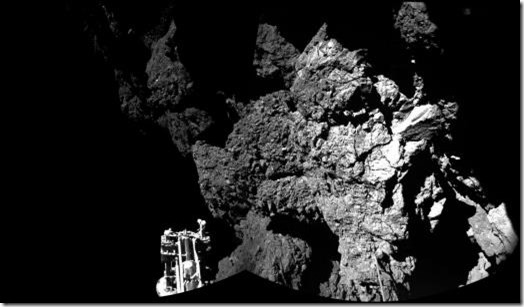Here’s the first Philae image from the surface of Comet 67P/Churyumov-Gerasimenko (taken from the ESA website) by Philae – the small lander which touched down yesterday,
It’s quite intriguing. After a lifetime of being told that comets are balls of “dirty snow” it looks pretty rocky. It also looks pretty solid, even though we’ve been repeatedly told it’s more like a big sponge since Rosetta arrived earlier this year.
It turns out that Philae’s fixing harpoons didn’t fire on landing, nor did its securing screws manage to bury themselves in the supposed icy surface. So it is just sitting there in a low gravity environment and – it would appear – on the edge of a steep drop. Fingers crossed that it stays put and does what it is programmed to do.
It also seems that when it first hit the ground (the one reported at around 4pm yesterday), it bounced hundreds of metres and took a further two hours to land again. Then, following a smaller bounce, it landed once more seven minutes later and finished in its current location.
Note that ESA images are larger than the one I’ve put here (I resize them to fit the page).
The latest news is that Philae eventually settled in the shadow of a cliff, and this may affect how well it can charge its batteries since the solar panels are not fully illuminated. One of its feet is apparently off the ground. The first bounce took it about 1km back into space before it landed again 2 hours later. After a smaller bounce, there is a suggestion that it is resting against a wall of some sort. It may even be lying on its side.
Although Philae weighs about 200kg here on earth, the very low gravity on 67P means that up there it only weighs about 1 gramme, so it could easily be thrown into space again, especially if comets vent anything like the one in the film Armageddon did. Having said that, one thing we HAVE discovered is that comets – this one certainly – are nothing like we have believed them to be for the last 100 years. There is also a worry that attempting to use Philae’s drill might move it, though this might be tried to positive effect when battery power begins to fail and all other data are obtained. Another possibility is that as 67P nears the sun then there may be more light and Philae will wake up.
You have to remember that there was only ever a 75% chance of success with the Philae part of the mission. Rosetta itself has achieved 100% of its goals, and if Philae never manages to drill, the images sent back by it mean that it has been successful beyond all realistic expectations. The entire mission has been the most spectacularly successful since Apollo 11 in 1969.